前回 Pt.6 では、アセテート録音機の誕生、そこで使われていたカッターヘッドの記録特性、横振動盤再生時の高調波歪の論文、1938年時点での超軽量ピックアップの開発など、あれこれについて調べました。
On the previous part 6, I studied on the advent of instantaneous lacquer disc recorders, frequency responses of the instantaneous cutterheads, an important paper on harmonic distortion of phonograph reproduction, development of ultra-lightweight pickups in 1938, etc.
今回はその続きで、ジュークボックス の登場、圧電式ピックアップ の登場、時代の徒花(?) 定振幅録音特性システムの試み について学んでいきます。1942年(放送局トランスクリプション用)NAB録音再生カーブの策定、そして戦後のマイクログルーヴLP時代まで、あともう少しという感じです。
This time, I am going to continue learning the history, including an advent of “jukebox” players and piezoelectric pickups, as well as the attempt of “constant-amplitude” recording/reproducing that proved abortive.The standardization of the 1942 NAB curve (for electrical transcription discs) and the advent of microgroove LPs are just a few steps ahead.
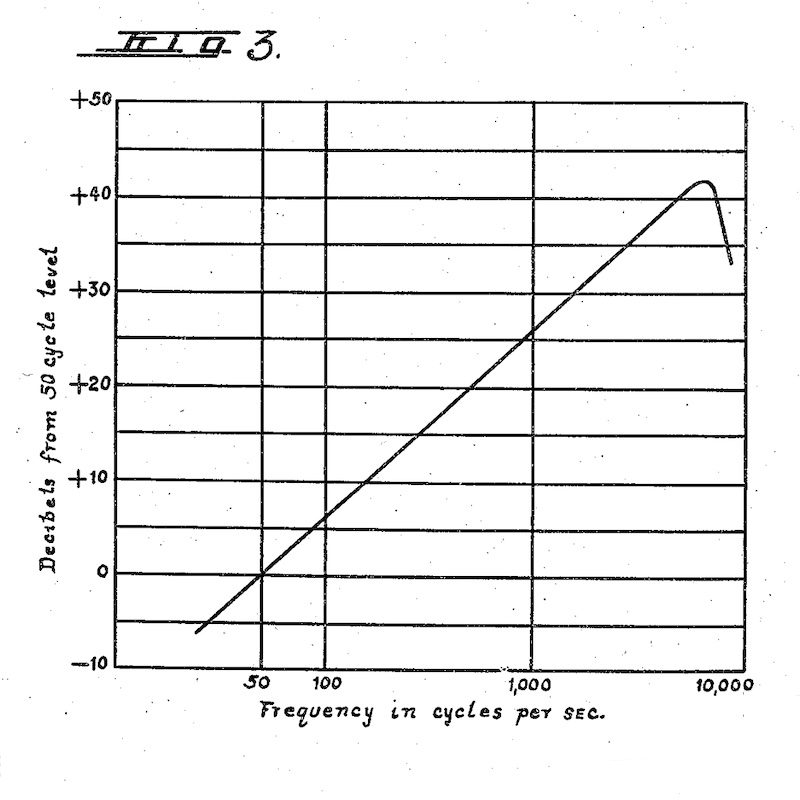
source: “Sound recording and reproducing system”, US Patent 2,139,916, by Stuart W. Seeley.
- 「Pt.0 (はじめに)」
- 「Pt.1 (定速度と定振幅、電気録音黎明期)」
- 「Pt.2 (世界初の電気録音、Brunswick Light-ray、ラジオ業界の脅威)」
- 「Pt.3 (Blumlein システム、当時のRCAやColumbia、民生用における高域プリファレンスの萌芽)」
- 「Pt.4 (Vitaphone、Program Transcription、Electrical Transcription、Bell Labs / Western Electric 縦振動トランスクリプション盤)」
- 「Pt.5 (ベル研とストコフスキーのエピソード、横振動トランスクリプション、Orthacousticカーブ)」
- 「Pt.6 (アセテート録音機のカッターヘッド特性、高調波歪の論文、超軽量ピックアップ)」
の続きです。
This article is a sequel to “Things I learned on Phono EQ curves, Pt.0”, “Pt.1”, “Pt.2”, “Pt.3”, “Pt.4”, “Pt.5” and “Pt.6”.
毎回書いている通り、筆者自身の学習過程を記したものですので、間違いの指摘や異論は遠慮なくお寄せください。
As I noted in every part of my article, this is a series of the footsteps of my own learning process, so please let me know if you find any mistakes on my article(s) / if you have different opinions.
今回も相当長い文章になってしまいましたので、さきに要約を掲載します。同じ内容は最後の まとめ にも掲載しています。
Again, this article become very lengthy – so here is the summary of this article (the same contents are avilable also in the the summary subsection).
1880年にキュリー兄弟によって実証された圧電効果 (Piezoelectric Effect) は、第一次大戦中に潜水艦ソナーの技術として使用されたことをきっかけにして、1920年代以降多方面での応用が進み、音響分野においてもロッシェル塩によるクリスタル素子がスピーカ、ヘッドフォン、マイクなどに活用されはじめた。特に、圧電式ピックアップ(カートリッジ)は、1930年代後半からジュークボックスを中心として採用が進んだ。
Piezoelectric Effect, discovered and demonstrated by the Curie brothers in 1880, was adopted in the invention of ultrasonic submarine detector during the WWI. This lead further development and applications of piezoelectric elements into many fields, including piezoelectric speakers, piezoelectric headphones, piezoelectric microphones, etc. using Rochelle salt elements, in the audio/acoustic field. In the late 1930s, piezoelectric pickups became gradually popular, especially on the jukeboxes.
マグネットピックアップと異なり、圧電ピックアップは定振幅特性を備えているため、当時の録音EQカーブで記録されたレコードを、再生EQなしで(正確ではないものの)まずまず再生することが可能である。また、出力が非常に大きいのでプリアンプも不要になる。このようなメリットが、ジュークボックスや大衆向け廉価プレーヤでの採用を加速させた。一方、圧電素子は湿度と温度に敏感であるためデリケートな扱いが必要であり、また正確な再生を行うのは難しいため、歴史が証明する通り、マグネットピックアップを置き換えるには至らなかった。
Unlike magnetic pickups, piezo-electric pickups have constant-amplitude characteristic, that enables “so-so” playback (although not precise) without using playback compensators. Also, piezoelectric pickups’ output voltage is way higher than that of magnetic pickups, and no need of preamplifiers. These merits accelerated the rapid adoption of piezoelectric pickups in the jukeboxes industry, as well as for inexpensive phonograph players for consumers. On the other hand, piezoelectric elements are very sensitive to dampness and temperature, and the pickups need to be taken delicate care. As a result, as the history proves, piezoelectric pickups never expelled magnet pickups from the de facto standard as phono reproducers.
非常に興味深いことに、圧電素子を強力に推進していた Brush Development が1940年〜1941年頃に、クリスタルカッターヘッドで定振幅記録、クリスタルピックアップで再生すれば、録音時にも再生時にもイコライザ不要になるという主張を各種論文や雑誌に展開していたが、結局1942年にNAB標準規格が採用されるに至り、日の目をみることなく歴史に埋もれることとなった。
Interestingly enough, Brush Development Corp. frequently promoted the merit of “constant-amplitude recording/reproducing” using crystal cutters and crystal pickups, without the need of equalizers. That claim was often read in several papers and technical article in 1940 and 1941, but it never saw the light of day, and in 1942 NAB Standards was adopted in the industry.
Contents / 目次
- 7.1 Advent of Lightweight Piezoelectric Crystal Pickups / 軽量クリスタルカートリッジの登場
- 7.1.1 Crystal Pickups and Jukeboxes / クリスタルカートリッジとジュークボックス
- 7.1.2 Earliest example of Jukebox with Crystal Pickup / クリスタルピックアップ搭載ジュークボックスの最初期の例
- 7.1.3 Earliest examples of Crystal Reproducers / クリスタルピックアップの最初期の例
- 7.1.4 Why Piezo-electric Pickups were popular / なぜ圧電型ピックアップが普及したのか
- 7.1.4 Brush Development Aiming to Familiarize Constant Amplitude Recording / 定振幅録音普及を目論む Brush Development
- 7.1.5 Disadvantages of Piezoelectric Cutters/Pickups / 圧電型カッターやピックアップの弱点
- 7.2 The summary of what I got this time / 自分なりのまとめ
7.1 Advent of Lightweight Piezoelectric Crystal Pickups / 軽量クリスタルカートリッジの登場
ジャック・キュリー (Jacques Curie) とピエール・キュリー (Pierre Curie) の兄弟によって1880年に実証された 圧電効果 (Piezoelectric Effect)、さらに1881年に実証された 逆圧電効果 (Inverse Piezoelectric Effect) は、第一次世界大戦中の1917年にポール・ランジュヴァン (Paul Langevin) らによって潜水艦の超音波探知機(ソナー)の発明によって一躍注目を浴び、さらなる研究や各分野への実用化が進んでいきました。
The Curie brothers – Jacques Curie and Pierre Curie – discovered and demonstrated Piezoelectric Effect in 1880, followed by the demonstration of Inverse Piezoelectric Effect by them in 1881. Then during the WWI in 1917, Paul Langevin et al developed an ultrasonic tranducer for use on submarines (ultrasonic submarine detector) using thin quartz crystals. This invention lead intense development interest in piezoelectric devices, and many further researches and applications followed.
ちなみに、キュリー兄弟による1880年の論文 “Développement par compression de l’électricité polaire dans les cristaux hémièdres à faces inclinées” (傾斜面が半面像型をなす結晶体における応力による電気分極発生)は、いまでもインターネット上で読むことができます。。。といってもフランス語なので、英語に自動翻訳しないと私は読めませんが(笑)
By the way, the original paper by the Curie brothers “Développement par compression de l’électricité polaire dans les cristaux hémièdres à faces inclinées” (Development, via compression, of electric polarization in hemihedral crystals with inclined faces) can be read now on the internet – although it was written in French and I have to get it machine-translate to read in English 🙂
強い圧電効果を持つロッシェル塩(酒石酸カリウムナトリウム)の最初期の応用例として、アレクサンダー・M・ニコルソン (Alexander M. Nicholson) がベル研在籍時の1917年に行った 水晶発振器 (Crystal Oscillator) の研究、および1921年のウォルター・ガイトン・キャディ (Walter Guyton Cady) による水晶発振器の開発・製造があげられます。この水晶発振器は、我々が現在使うコンピュータなど電子機器のクロックとしても日々お世話になっているものです。
One of the earliest applications of Rochelle salt (Potassium sodium tartrate) was the research of crystal oscillators by Alexander M. Nicholson (1917) when he was at the Bell Labs, and the development and production of crystal oscillators by Walter Guyton Cady (1921). Crystal oscillators are essential and fairly common in many electrical components and computers we use today.
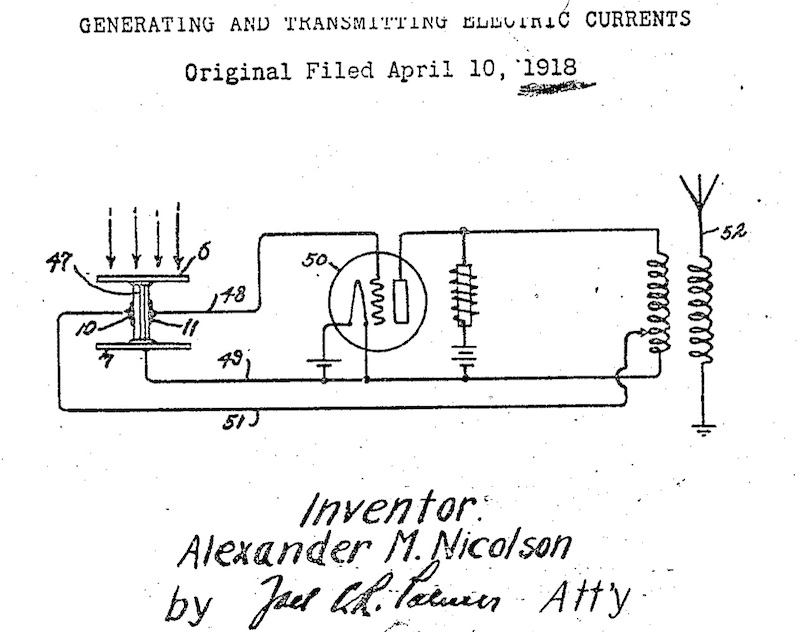
source: “Generating and Transmitting Electric Currents”, US Patent 2,212,845, Alexander M. Nicolson, filed 1918
1918年に提出された水晶発振器の特許文書に掲載された図版
音響分野では、ランジュヴァンのソナー発明に関連して 圧電型マイク(クリスタルマイク)が生まれました。また、圧電型スピーカ などにも応用が進みました。なかでもロッシェル塩を使ったデバイスを精力的に開発していたのが Brush Development 社で、1932年にはラジオ局等放送設備用として圧電スピーカの販売を開始した、という記載が Electronics 誌1932年11月号にありました。
In the acoustic engineering field, piezoelectric microphones (crystal microphones) were invented, as an application of Langevin’s sonar development; piezoelectric speakers were also developed. One of the main drivers of piezoelectric elements (Rochelle salt) was Brush Development Corporation – the company started selling piezoelectric (crystal) speakers for the radio and public-address fields, according to the news on the Nov. 1932 issue of the Electronics magazine.
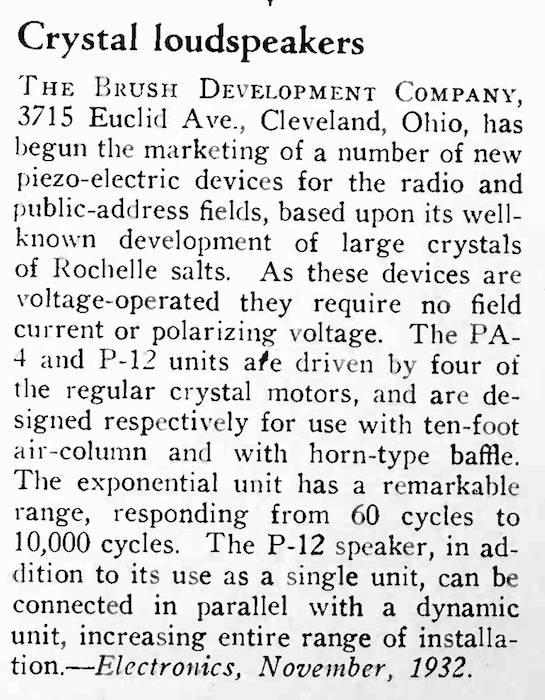
source: Electronics, November 1932, p.352.
Brush Development 社による圧電スピーカ販売開始を伝える記事
Brush Development は圧電型ヘッドフォンも製造販売していました。Type A と呼ばれるヘッドフォンは、60Hz〜10,000Hz の周波数帯域でフラットレスポンスだったそうです。
Brush Development also developed and sold piezoelectric headphones/earphones. The “Type A” headphone had a wide range and uniform frequency response covering from 60Hz to 10,000Hz.
また1935年に シュア (Shure) が Model 70 や Model 71 などクリスタルマイクをラインアップに加えたのが知られています。これは Brush Development の保有する特許を使ったものだったようです。
The famous Shure Brothers company also entered into the development of piezoelectric components: in 1935, Shure added crystal microphones like Model 70 and Model 71 to their product lineup, under the license of Brush Development.
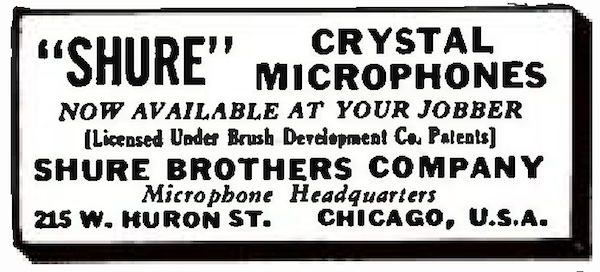
source: Shure Crystal Microphone Ad, Radio-Craft, February 1935, p.504
Radio-Craft 誌1935年2月号に掲載された、Shure のクリスタルマイクの広告
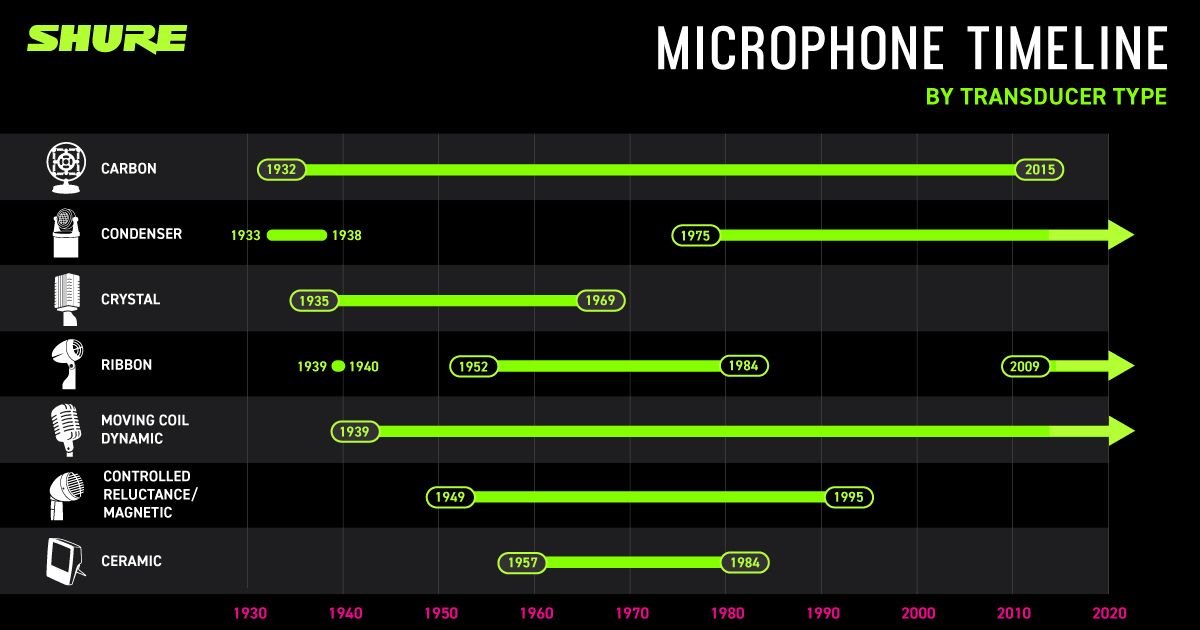
source: “The History of Crystal Microphones and Artifacts from the Shure Archives”
Shure は1935年〜1969年にクリスタルマイクロフォンを製造販売していました
そして、1933年、その シュア (Shure) が、OEM用として圧電フォノピックアップ(クリスタルカートリッジ)を製造開始した、とシュアの公式回答「A Brief History of Shure Phonograph Products: 1933 – 1998」に記録されています。ただし、1933年当時のクリスタルカートリッジの記事や広告は見つけられませんでした。
Then in 1933, Shure “began to supply OEM crystal pickups to various manufacturers of record players”, according to the article “A Brief History of Shure Phonograph Products: 1933 – 1998”, although I still can’t find the articles nor the advertisements of Shure’s crystal pickups in 1933 or 1934.
7.1.1 Crystal Pickups and Jukeboxes / クリスタルカートリッジとジュークボックス
この最初期のクリスタルカートリッジは、主に ジュークボックス (jukeboxes) で使われていたようです。当初は「コイン式蓄音機」(Coin-operated phonographs) と呼ばれていたそうです。ともあれ、1929年の世界大恐慌に始まり1930年代前半は、レコード業界はどん底の時代でしたが、1930年代後半に入り、このジュークボックスのおかげもあって、徐々に業界の勢いが復活していきます。
The early crystal (thus piezo-electric) pickups were often used on jukebox machines. Jukeboxes were initially called “coin-operated phonographs”. After the rock-bottom years of 1929’s Great Depression and the early 1930s, record industry gradually regained the upswing in the late 1930s – one of the most important factors was the popularity of jukebox machines.
なぜ「コイン式蓄音機」が「ジュークボックス」と呼ばれるようになったのか、については諸説あるようですが、アメリカ南部のクリオールのガラ語の「jook / joog」(無法、騒々しい、邪悪)という用語が転じて、遊郭と遊技場とダンスホールが混在したようなベニューのことが「jook house」や「jook joint」と呼ばれており、そのようなベニューに設置されていたコイン式蓄音機のことを指して「juke-box」と呼ばれるようになったそうです。「ジュークボックス」という用語の初出は Time 誌1939年9月4日号 と言われているそうです。
It is known that there are several opinions on why the “coin-operated phonograph machines” were called “jukeboxes”. One of the possible opinion is this: the term “juke” originates from “jook” or “joog” of the Gullah language (one of the creole languages), meaning “bad, wicked, disorderly” etc.; then “a disorderly house, often a combination of brothel, gaming parlor and dance hall” was called “jook house” or “jook joint”; and finally the coin-operated phonographs were called as “juke-box”. One of the earliest appearance of the term “jukebox” was on September 4, 1939 issue of Time magazine.
Once the upswing had its initial bounce, other factors kept it moving. Most important of these was the popularity of the slot machine or “juke box” which retailed melody in small barrooms, lunch-counters and dance joints at 5¢ a shot. With an estimated consumption rate of more than 30,000,000 discs annually, the 300,000 juke boxes in the U. S. are today the record industry’s largest customer. Another boost, accounting for perhaps 25% of record sales in today’s popular field, came from the argumentative aficionados of swing, whose number mushroomed with the nation-wide vogue for hot jazz in 1935.
(どん底を脱して1934年頃からレコードの売り上げが)盛り上がりをみせると、その勢いは止まらなくなった。中でも最も重要なのは、小さな酒場、ラウンチカウンター、ダンスジョイントなどで、1曲5セントで音楽を小売りするスロットマシン、いわゆる「ジュークボックス」の人気であった。現在米国内に30万台あるジュークボックスは、レコード業界にとって最大の顧客であり、年間3,000万枚が消費されていると推定されている。もうひとつの追い風として、ポピュラージャンルにおける25パーセントの売り上げを占めているのが、スウィング音楽の愛好家である。1935年には全米でホットジャズが流行し、その売り上げが急増した。
Today the juke boxes, the individual buyers of popular discs, and the swing fans together account for 88%-to-90% of all record sales. But, dollar for dollar, they contribute only 70% of the money spent on records in the U. S. The remaining 30% is spent by the collectors of classical records. The classic-collectors have grown slowly and steadily ever since high-fidelity recording began to catch the finer points of symphonic scoring. The industry today regards them as its most stable market. Most important distributor to this market is Manhattan’s 11-year-old Gramophone Shop, which deals almost exclusively in classical discs, has 50,000 active buyers, and claims to be the largest record retailer in the U. S.
こんにち、ジュークボックスに加え、ポピュラー盤の個人購入、スウィングファンの個人購入を合わせると、レコードの全売り上げ枚数の88%〜90%を占めている。しかし売り上げ金額でいうと、全米で70%に留まっている。売り上げの残り30%はクラシックレコードのコレクターによるものである。ハイファイ録音により交響曲の細かい音が聞こえるようになり、クラシックのコレクターも徐々に増えている。業界では現在、このクラシックコレクターを最も安定した市場・顧客として位置付けている。マンハッタンに居を構える創業11年の「グラモフォンショップ」という店舗が、この市場にとって最も重要な販売店であり、扱うのはほぼクラシック音楽の盤のみ、5万人のアクティブバイヤーを抱え、米国最大のレコード小売店であると主張している。
Music: Phonograph Boom, Time Magazine, Sept. 4, 19397.1.2 Earliest example of Jukebox with Crystal Pickup / クリスタルピックアップ搭載ジュークボックスの最初期の例
で、私が見つけることができた、「クリスタルピックアップを搭載したジュークボックス」に関する最も古い記事は、The Billboard 誌1936年3月21日号の “Report Record Cash Transaction On Rock-Ola Multi-Selector Phonos” です。ちなみに興味深いことに、まだこの時点では「jukebox」という単語は登場しておらず、「automatic music machine」(自動音楽機)と書かれています。
Well, the earliest article I could find (that deals with jukeboxes equipped with crystal pickups) was “Report Record Cash Transaction On Rock-Ola Multi-Selector Phonos”, on March 21, 1936 issue of The Billboard magazine. By the way, it is itneresting that the article doesn’t use the term “jukebox” yet: instead it reads “automatic music machine”.
この記事中で、Rock-Ola社の社長による「弊社の自動演奏機は業界で唯一、新型の軽量クリスタルピックアップを搭載しており、これにより再生針交換費用や(摩耗した)レコード交換費用を3分の1にまで削減可能である」というコメントが掲載されています。
This article includes the comment by Sam Kresberg (president of Rock-Ola Manufacturing Corporation): “(…) it is the only phonograph with the new lightweight crystal pickup, which cuts the operator’s expense in needle and record purchases to almost one-third.”
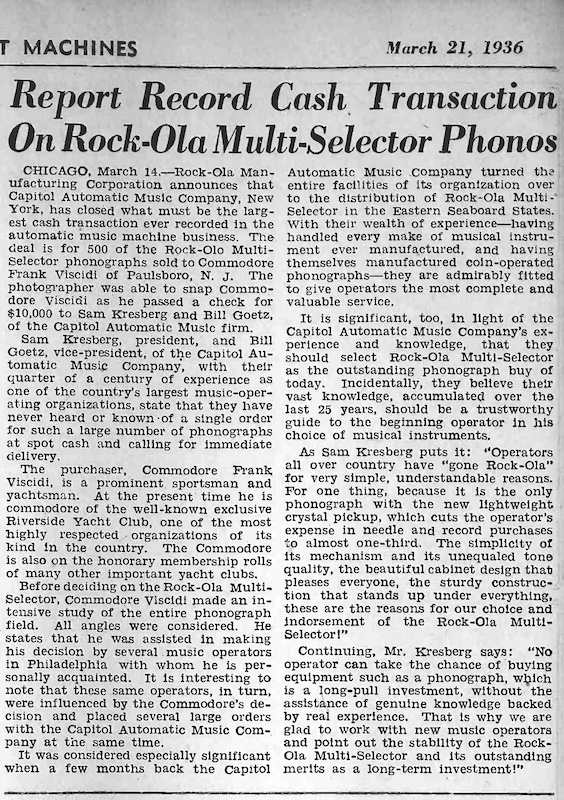
source: “Report Record Cash Transaction On Rock-Ola Multi-Selector Phonos”, The Billboard, March 21, 1936, p.70
そして、同じく The Billboard 誌の1936年10月3日号には、Rock-Ola ジュークボックスの広告が掲載されています。そこでは「軽量クリスタルピックアップ搭載!」「Rock-Ola 独占販売!」「専門家曰く『クリスタルピックアップはじきに業界を席巻するであろう』」「レコードと針の寿命を倍増させる」「針圧はたったの3オンス (約85g)」と誇らしげに謳われています。
Also the Oct. 3, 1936 issue of The Billboard magazine contains the advertisement of Rock-Ola jukebox machines, with full of self compliments like this:
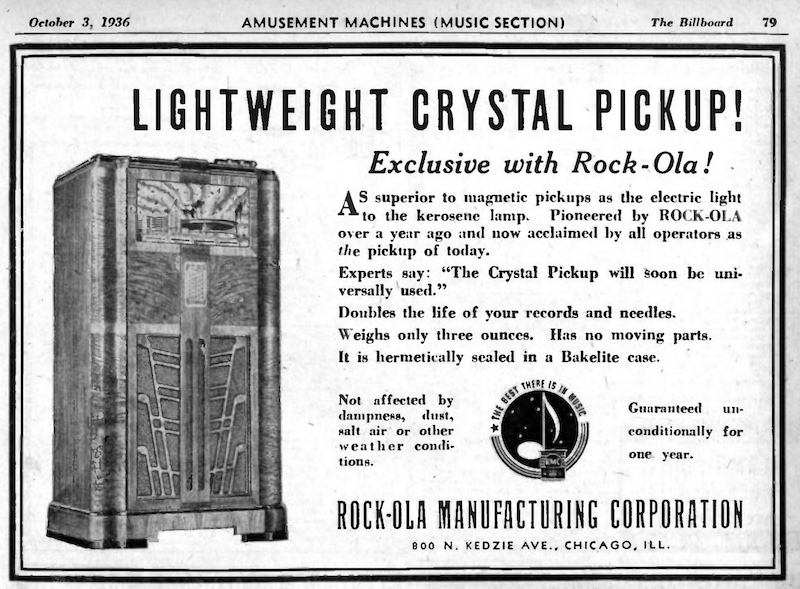
source: Rock-Ola Manufacturing Corporation Advertisement, The Billboard, October 3, 1936, p.79
7.1.3 Earliest examples of Crystal Reproducers / クリスタルピックアップの最初期の例
1937年のシュアのカタログに、Model 99A が掲載されています。トーンアームとピックアップ一体型で、この ZEPHYR クリスタルピックアップがいかに高性能であるか記されています。12インチレコードおよび10インチレコード用と書かれており、トランスクリプション盤用ではなく、市販のレコード再生用のトーンアームであることがわかります。写真を見る限り、針は鉄針に見えます。また針圧は掲載されていませんが、1939年カタログの改良版 Model 99C では 2¾オンス(約78g)と書かれているので、99Aもこの針圧に近いと思われます。出力は 1,000Hz で 1V (!) と書かれています。
Shure’s 1937 Catalog has the dedicated page for Model 99A, crystal phonograph reproducer (tonearm + pickup), showing off how excellent this ZEPHYR crystal pickup is. This reproducer is not for electrical transcription but for regular 78 rpm records, as the description says it plays 12-inch and 10-inch records. Also, judging from the photo, this reproducer uses exchangeable steel needles. The needle pressure is not specified here, but the needle pressure of the Model 99C (as appeared on the Shure’s 1939 Catalog) was 2¾ ounces (approx. 78 grams), so that of 99A would be very similar. Furthermore, the output voltage is approximately 1 volt (!) at 1,000Hz.
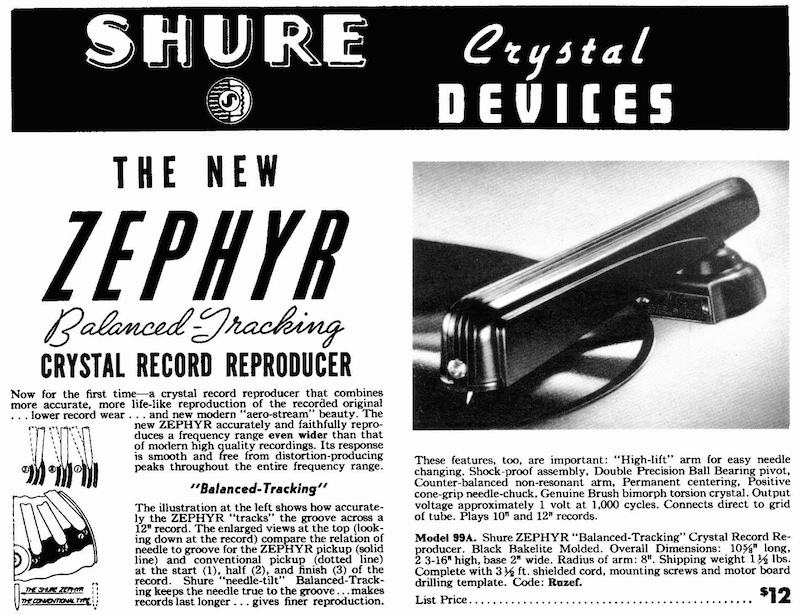
source: Vintage Shure Catalogs (1933 and later), Shure Incorporated.
1937年シュア総合カタログに掲載された Model 99A クリスタルピックアップ
同じくシュアのカタログの1938年版になると、Model 99A の改良版 Model 99B のほか、9月1日以降販売と書かれた、トランスクリプション盤再生用のクリスタルピックアップとトーンアーム Model 912A も掲載されています。こちらの針圧は 2½オンス(約70.8g)と記載があります。また、出力は 1,000Hz で 3V (!!) と書かれています。
Next year, Shure’s 1938 Catalog presents the Model 99B (a refined model of 99A), as well as Model 912A for electrical transcription, with the caption “available after September 1, 1938”. This transcription reproducer has the needle pressure of 2½ ounces (approx. 70.8 grams). Also, the output voltage is 3V (!!) at 1,000Hz.
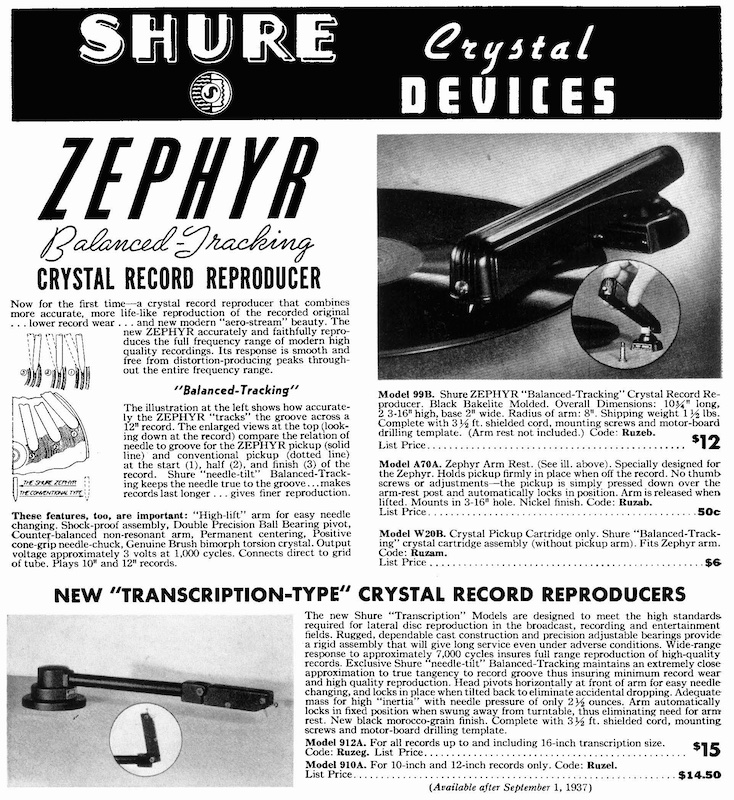
source: Vintage Shure Catalogs (1933 and later), Shure Incorporated.
1938年シュア総合カタログに掲載されたクリスタルピックアップ群
99B は前年の99Aの改良版と思われ、16インチトランスクリプション用の912Aも追加されています。
RCA Victor の1937年サービスノートという文書に、オートチェンジャー用のクリスタルピックアップとトーンアーム No.14848 が掲載されています。ピックアップの周波数特性は 45Hz〜7,000Hz と書かれています。このアームが標準装備されたオートチェンジャー No.9820 の説明によると、標準針圧は3オンス(約85g)とのことです。また、針はトップローディングで交換可能とあり、やはり鉄針が使われていたように見えます。
Even RCA Victor had crystal pickups and tonearms in their lineup. 1937 edition of their “Service Notes” contains No.14848, a crystal pickup and tonearm for automatic record changers. The frequency response of the crystal pickup was 45Hz to 7,000Hz. And according to the description of the automatic record changer No.9820, the needle pressure was 3 ounces (approx. 85 grams). The needle exchange was done from the top of the tonearm/pickup, so the steel needle was used for this pickup.
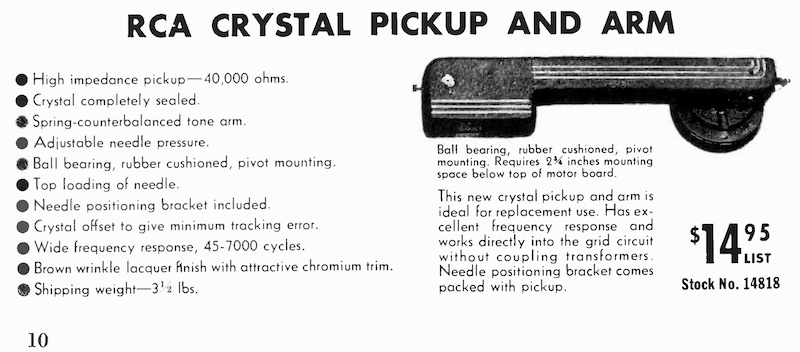
source: RCA Service Notes, 1937
RCA Victor サービスノート(製品メンテ用マニュアル)に掲載されたクリスタルピックアップの広告
クリスタルピックアップや、後のセラミックピックアップといった、圧電型ピックアップの変遷については、とりあえずこの辺りにしておきますが、戦後のLP時代を含め、家庭用の電蓄や安価なオーディオ機器、ステレオセットにおいて、1960年代〜1970年代まで広く使われ続けました。
…I had better stop now for the history and evolution of the piezo-electric pickups like crystal/ceramic cartridges. Anyway, such piezo-electric pickups had been frequently/often used for home phonograph players and inexpensive audio components and stereo sets, until 1960s or even 1970s.
7.1.4 Why Piezo-electric Pickups were popular / なぜ圧電型ピックアップが普及したのか
現在最も一般的な、コイルやマグネットを使ったピックアップと異なり、圧電型ピックアップは全く違う特性を備えています。
The most interesting fact about Piezo-electric pickups is that it has completely different response characteristic from that of conventional pickups we usually use – magnetic pickups (moving-coil, moving-magnet, moving-iron, etc.).
まず、マグネットピックアップの場合、出力が数mV程度です。MC型の場合には0.2mVなんていうものも少なくありません。そのため、プリアンプによる増幅が必要になります。一方、クリスタルカートリッジやセラミックカートリッジは、数Vもありますので、出力の大きさ的には増幅不要でアンプに直接入力が可能です。1940年シュアカタログに掲載されたクリスタルピックアップ Model W20C のスペックには、出力が 2 ¼V と書かれています。
In the first place, magnet pickups has output voltage of a few milivolts. Some moving-coil pickups only have output voltage of 0.2mV. Because of this low output, it needs a preamplifier to get the output amplified before feeding into the power amplifier. On the other hand, piezo-electric pickups like crystal pickups and ceramic pickups have output voltage of several volts – no need of preamplification. For example, Shure’s crystal pickup Model W20C has output of 2 ¼ volts, according to Shure’s 1940 Catalog.
次に、マグネットピックアップの場合は、基本的に定速度特性を持っているのに対して、圧電型ピックアップは、基本的に定振幅特性を持っています。低域で定振幅の減衰、高域で定振幅に近い増幅を録音用EQを使って施し記録されたレコード盤を再生する際、正確な再生カーブではないものの、再生用EQなしに「そこそこ」再生してくれます。
Secondly, piezo-electric pickups have constant-amplitude characteristic, while magnet pickups have (basically) constant-velocity characteristic. This means, when a regular record (cut with some recording equalization, with de-emphasized in the bass region, and with pre-emphasized in the treble region) is played with a piezo-electric pickup, the bass region is boosted and the treble region is attenuated, without the use of playback compensator/equalizer, although not perfect at all.
マグネットピックアップと圧電式ピックアップの周波数特性の違いは、1935年に RCA が提出した特許文書 “Sound Recording and Reproducing System” を見るとよく理解できます。クリスタルピックアップが出回りはじめていたちょうどその時期に、なぜかあの RCA が定振幅録音再生システムの特許を提出していたのです。もしかしたら Brush Development への対抗措置として特許だけとっておいたのでしょうか(詳細は不明です)。
The frequency response difference between magnet pickups and piezo-electric pickups can be easily understood by inspecting the graph shown on the RCA’s 1935 patent document “Sound Recording and Reproducing System”. It is very interesting that RCA filed the patent that was related to the constant-amplitude recording and reproducing – did RCA tried to file the patent to cope with Brush Development? (the real story is still unknown to me…)

source: “Sound recording and reproducing system”, US Patent 2,139,916, by Stuart W. Seeley.
定振幅 (constant amplitude) で盤に記録する際の周波数特性グラフ
この特性で記録された盤を圧電式ピックアップで再生するとフラットレスポンスになる
Frequency response of the disc recorded with constant amplitude characteristic
このような 6dB/オクターブの記録特性でディスクを記録すれば、ちょうど圧電型ピックアップでイコライザなしにフラット再生できることになります。
By recording the disc with the frequency response of such a 6dB per octave slope in the entire frequency range, piezo-electric pickups can obtain uniform playback response.
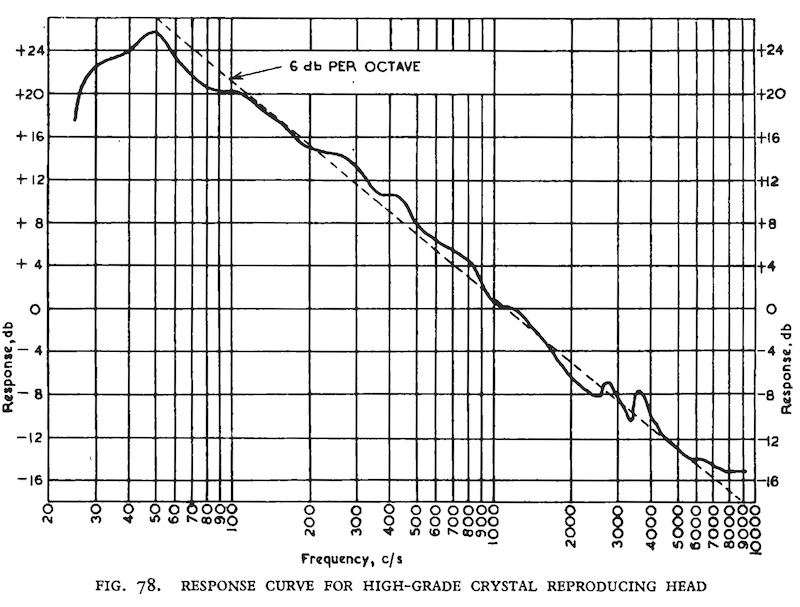
source: “BBC Recording Training Manual”, 1953, p.89.
1950年発行のBBC社員向けトレーニングマニュアルに掲載された、高性能クリスタルピックアップの再生特性
実際には、当時流通していた市販レコードやトランスクリプション盤は、このような記録特性ではありませんでしたが、低域部と高域部が定振幅に近い 6dB スロープで記録されていたので、ちょうど中間域の部分に目をつぶれば、「そこそこ」フラット「ぽい」再生がフォノイコ無しに可能、という理屈です。
As a matter of fact, phonograph records nor electrical transcription discs were NOT recorded this way: but the bass region was attenuated with constant-amplitude slope, and the treble region was pre-emphasized, so piezo-electric pickups play such records “so-so” with “pseudo-flat” or “quasi-flat” response, without the use of playback equalizer.
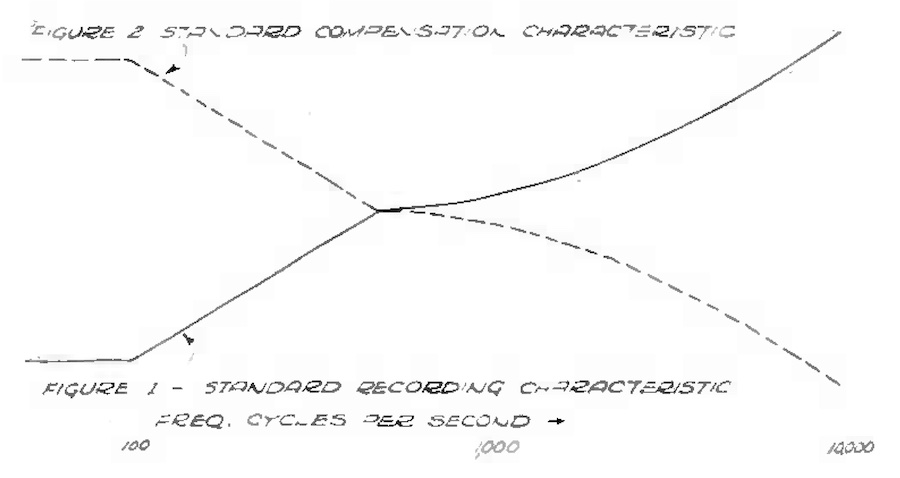
source: “RCA-NBC Orthacoustic Recording”, Robert M. Morris, ATE Journal, December 1939, pp.15-16
ATE Journal 1939年12月号に掲載された Orthacoustic 録音再生カーブ
Figure 1 (実線) が録音カーブ、Figure 2 (破線) が再生カーブ
当時のクリスタルカートリッジの再生周波数特性グラフがないか探したら、ありました。1941年11月にシュアが公開した Model 97A(鉄針)と 97AN(サファイア針)の、テストレコードを再生したグラフです。針圧は 1オンス (約28.35g) 〜 1 1/8オンス (約31.9g) と書かれています。
I had been looking for an example of playback response graph of piezo-electric pickups – and I found one. Below is the frequency response curves of Shure’s crystal pickups Model 97A (steel needle) and 97AN (sapphire needle), when a test record is played with those pickups. Needle pressures for these pickups were 1 ounce (approx. 28.35 grams) to 1 /8 ounces (approx. 31.9 grams), according to the Data Sheet published in November 1941.
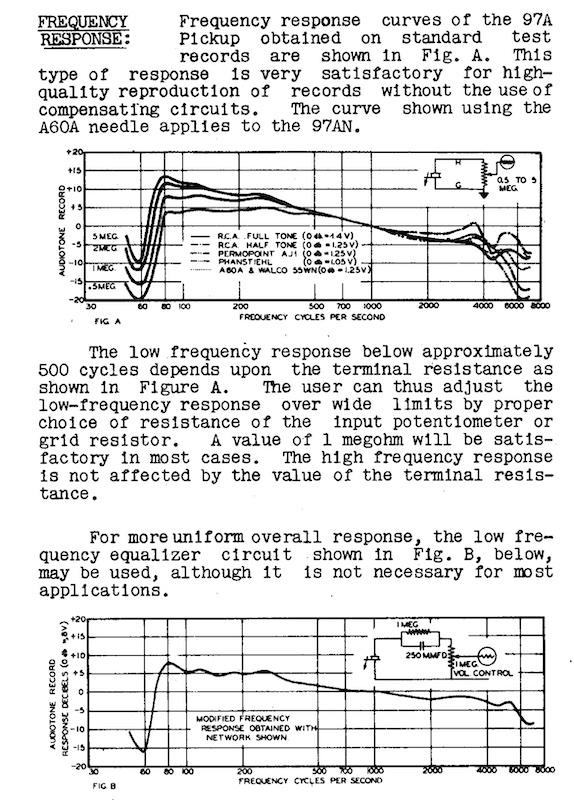
source: “Shure Brothers Data Sheet: Models 97A and 97AN”
1941年の Model 97A / 97AN の貴重な再生特性グラフ
Frequency response curves of the 97A and 97AN pickups
低域の盛り上がりは 0.5〜5MΩ(メガオーム)の終端抵抗で微調整するように書かれている他、より全体の応答特性をフラットな特性にするには、抵抗とコンデンサの並列回路を用意すると良いとも書かれています。いずれにせよ、マグネットカートリッジ用のいわゆる再生フォノイコよりも簡便な回路です。
According to the data sheet, the amount of the attenuation in the bass region can be configured with the terminal resistance of 0.5 to 5 megaohms. The data sheet describes another method, using a low-frequency equalizer circuit of a resistor and a capasitor for more uniform overall response. In both cases, they are relatively simpler circuit than playback equalizer circuits for magnetic pickups.
ともあれ、話をまとめると、圧電型ピックアップの
- 出力が大きい=プリアンプによる増幅が不要、
- 定振幅特性=フォノイコなしで(正確ではないものの)そこそこの再生が簡便に実現可能、
- そしてマグネットピックアップより廉価。
といった特徴が、1930年代中頃から1970年代頃まで、安価な電蓄や入門用オーディオ機器などを中心に広く使われていた理由でしょう。
Anyway, to rougly summarize, piezo-electric pickups have such characteristics as:
- high output voltage = no need of preamplifier,
- constant-amplitude characteristic = “pseudo-flat” playback with “so-so” fidelity possible without playback equalizer,
- and cheaper than magnetic pickups,
and these are primary reason why piezo-electric pickups were widely used for inexpensive phonograph machines and introductory-level audio components.
It is interesting to note that the audio-voltage output of crystal pickups is not directly proportional to the amplitude and frequency of the stylus vibration. In hi-fi language, crystal pickups do not have flat frequency response. Actually, this is blessing in disguise. Crystal pickups boost the low frequencies (bass) and attenuate the high frequencies (treble). If you refer to the discussion of record compensation in Chapter 3, you will see that the frequency response (i.e., recording curve) of phonograph records shown in Figure 11 does the opposite. With records, the bass is attenuated and the treble is boosted. Thus, the crystal pickup automatically furnishes record compensation. It is not complete compensation since the response of both records and crystals vary. But crystal pickups do provide an average amount of record compensation.
興味深いことに、クリスタルピックアップ(圧電カートリッジ)の電圧出力は、針の振動の振幅や周波数に直接比例するわけではない。Hi-Fi 分野の用語でいうと、クリスタルピックアップはフラットな周波数特性を持っていない。実際はこれが不幸中の幸いで、クリスタルカートリッジは低音域を増幅し、高音域を減衰する。第3章で記したレコードの録音再生カーブの話題を参照してもらえばわかる通り、レコードにおける記録特性はちょうどこの逆であり、低音域が減衰され、高音域が増幅されて記録されている。このため、クリスタルピックアップは自動的に補正を行っていると言える。レコードの記録特性とクリスタルピックアップの再生特性は異なるため、完璧な補正にはならないが、クリスタルピックアップは平均的にまずまずの補正を行ってくれる。
Although crystals have the advantages of record compensation and a strong audio-voltage output requiring no preamplification, they also have faults. Crystals are affeted by dampness and temperature. In warm, damp climates they function poorly. Furthermore, although the frequency response of crystals follow the general characteristic of boosting bass and cutting treble, it does so somewhat erratically. For the best pickup we must consider the magnetic.
クリスタルピックアップは、レコード再生時の補正の点でメリットがあり、また高出力であることからプリアンプが不要になるメリットもあるが、欠点もある。クリスタルピックアップで使用される圧電素子は湿気と温度の影響を受けやすい。暖かく高湿度の環境では、圧電素子は正しく動作しない。加えて、低音域を増幅し高音域を減衰するという一般的な特性を備えてはいるものの、正確な再生時補正をしているとは言えない。よって、ベストなピックアップとしては、我々はマグネットカートリッジを考慮するべきであろう。
Hi-Fi Handbook, pp.48-50, William J. Kendall, Thomas Y. Crowell Company: New York, 19547.1.4 Brush Development Aiming to Familiarize Constant Amplitude Recording / 定振幅録音普及を目論む Brush Development
そしてさらに興味深いことに、この時期、圧電素子および圧電型ピックアップのトップを走っていた Brush Development が、矢継ぎ早に論文や技術記事を執筆しています。それらを見ると、今後圧電型ピックアップが一般的になるに従い、圧電型カッターヘッドも普及し、全帯域を定振幅録音すれば、録音用EQや再生用EQが不要になる、という未来を目論んでいたようなのです。
Even more interestingly enough, the Brush Development Corp., a leading company of Piezo-electric pickups, published several papers and technical articles in quick succession. Reading these articles might suggest that the Brush Development Corp. was aiming for the future of “recording and reproducing with NO equalization required” – constant-amplitude recording and reproducing using piezo-electric cutterheads and pickups.
ラジオ技術関連の Communications 誌、1940年3月号に、Brush Development の A.W. Duffield 氏が執筆した記事が掲載されています。そのタイトルは “Improvement in Disc Records Through Constant Amplitude Recording” というものです。全帯域の定振幅特性での録音再生により、ノイズリダクションに考慮しかつイコライズレスの録音再生が出来るメリットを力説しています。
A.W. Duffield of Brush Development wrote an article on the Communications magazine, March 1940 issue. The title was “Improvement in Disc Records Through Constant Amplitude Recording”. The author emphasis the merit that the constant-amplitude recording and reproducing (thus noise reduction being obtained) would be possible without utilizing recording/reproducing equalizers.
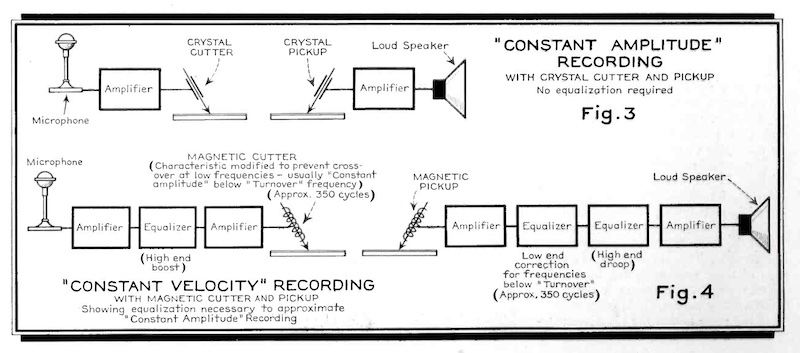
source: “Improvements in Disc Records Through Constant Amplitude Recording”, A.W. Duffield, Communications, March 1940, pp.13-14,28.
Brush Development の Duffield 氏が執筆した記事に掲載された図版
下の図4の一般的なマグネットカッター/ピックアップを使った場合、録音にも再生にもイコライザと追加のアンプが必要だが、上の図3の定振幅カッター/ピックアップの場合はイコライザが一切不要、と主張
学会誌 Proceedings of the I.R.E. 1940年9月号に掲載された “Some Problems of Disk Recording” では、本稿 Pt.6 で紹介した F.V. Hunt 氏の高調波歪の論文も引用しつつ、ディスク録音の様々な側面を論じていますが、自社開発のクリスタルカッターヘッド RC-20 による定振幅録音方式をさりげなく宣伝しているようにも読めます。
Then September 1940 issue of the Proceeding of the I.R.E. has the paper entitled “Some Problems of Disk Recording”, authored by S.J. Begun of Brush Development, discusses many factors of disc recording, referencing the F.V. Hunt’s paper of harmonic distortion (as we see in the Part 6 of my entire article) as well. But the author casually demonstrates Brush Development’s crystal recording cutter RC-20 in this paper.
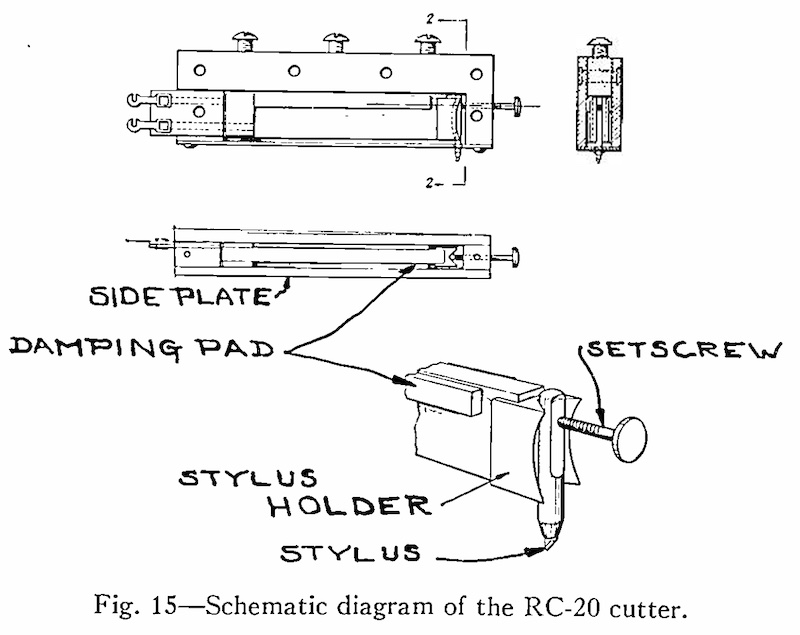
source: “Some Problems of Disk Recording”, S.J. Begun, Proceedings of the I.R.E., September 1940, Vol.28, No.9, pp.389-398.
Brush Development の Begun 氏が執筆した論文に掲載された RC-20 クリスタルカッターヘッド
上の論文を書いた S.J. Begun 氏はさらに学会誌 Journal of the Society of Motion Picture Engineers の1940年7月号にも “Temperature Controlled Disk Recording Cutter” という論文を掲載しています。カッターヘッドの温度制御による記録特性の安定化に関する内容ですが、ここでも自社のクリスタルカッターヘッドを登場させています。
S.J. Begun also published a paper on the Journal of the Society of Motion Picture Engineers, July 1940 issue, entitled “Temperature Controlled Disk Recording Cutter”. This paper deals with the stabilization of the recording characteristic by controlling the cutterhead’s temerature, but he also presents Brush Development’s crystal recording cutter in this paper.
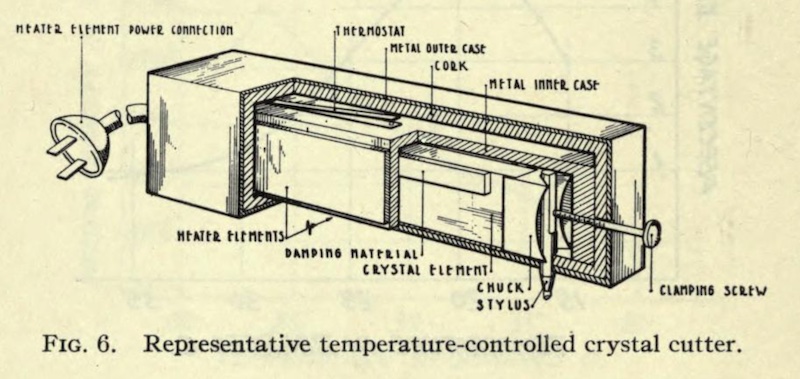
source: “Temperature Controlled Disk Recording Cutter”, S.J. Begun, Journal of the Society of Motion Picture Engineers, July 1940, pp.666-674.
同じくロッシェル塩の可能性にかけていた、Brush Development の盟友である Astatic Corporation も、1940年6月に圧電式カッターヘッドの特許を申請し、ポータブル式アセテート録音機用に圧電型カッターヘッドを開発・販売しています。
Astatic Corporation, a sworn ally of piezo-electric devices and also betting on the possibility of Rochelle salt crystal, filed the patent of piezo-electric recording cutterhead in June 1940; Astatic also developed and sold piezo-electric cutterheads for portable instantaneous recorders.
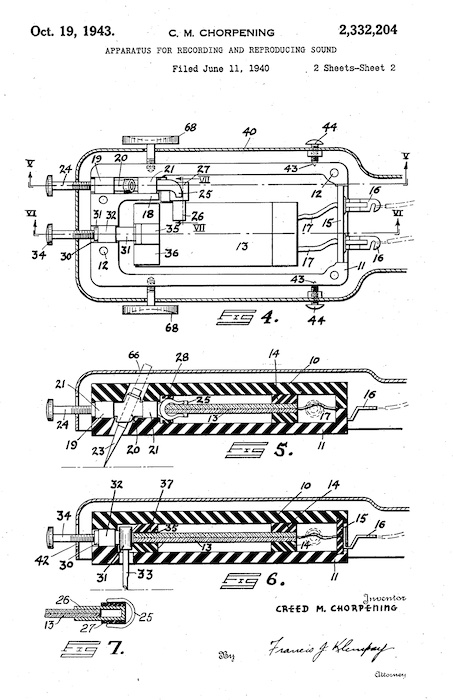
source: “Apparatus for recording and reproducing sound”, US Patent 2,332,204, Creed M. Chorpening, filed 1940
1940年に提出された、圧電セラミック素子を使った録音カッターと再生ピックアップの特許文書に掲載された図版
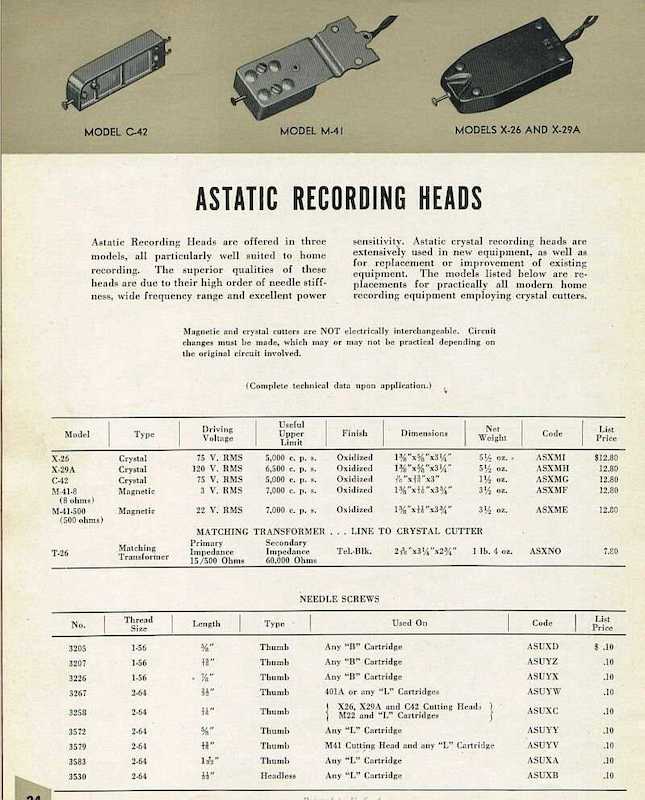
source: “magnetic cutting heads for suitcase cutters?”, tragwag, at Lathe Trolls.
Astatic X-26, X-29A, C-42 という圧電型カッターヘッドが、ポータブル式アセテート録音機用に販売されていたようです
さらに、Brush Development も、放送局用 ATE Journal 誌の1941年1月号に、アセテート盤再生用として PL-20 と PL-50 という、圧電型ピックアップを装着したトーンアームの記事を掲載しています。その記事では「PL-20 ピックアップを適正針圧である30グラムで使用した場合、(アセテート盤を)150時間連続再生しても、6,000Hz のテストトーンの摩耗による減衰は 2.5dB に留まり、4,000Hz テストトーンの場合は減衰が一切観測されなかった」と書かれており、当時のマグネットカートリッジに比べて非常に軽い針圧を誇っている様子が伺えます。
Furthermore, Brush Development published the article on the ATE Journal, January 1941, regarding PL-20 and PL-50 piezo-electric phono pickups for instantaneous disc reproduction. In this article, the author A.P. Dunk writes: “It has been found that by using the proper stylus force of 30 grams on the PL-20 pickup, 150 hours of continuous playing reduces the output level for a 6,000 cycle tone only 2 1/2 db, while for 4,000 cycles practically no reduction in output level was observed”, proudly presenting lower needle pressure than that of many magnet cartridges (at that time).
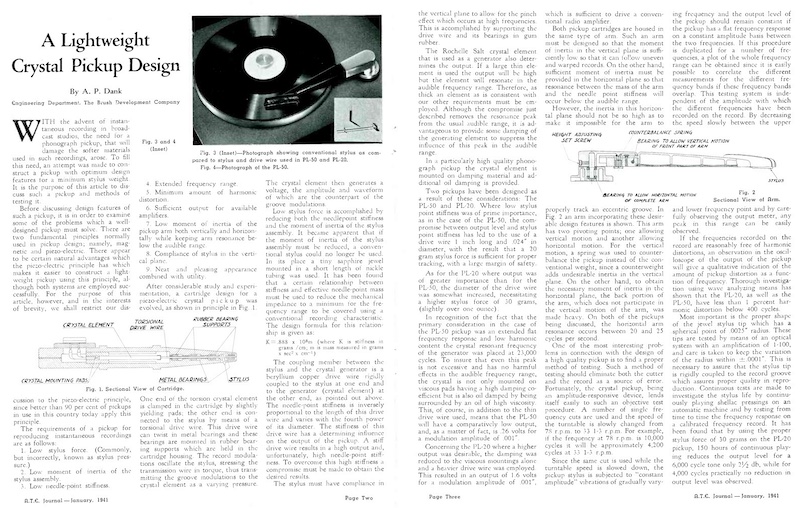
source: “A Lightweight Crystal Pickup Design”, A.P. Dunk, ATE Journal, January 1941, pp.2-3
ATE Journal 1941年1月号に掲載された軽量クリスタルピックアップの解説記事
そして Brush Development を代表して、S.J. Begun 氏は、本稿の続編で紹介する NAB 録音・再生規格委員会のメンバとして1941年8月から参加をしていました。
Then, finally, S.J. Begun, representing Brush Development Corp., participated the NAB’s Recording and Reproducing Standards Committee and was a member of the committee since August 1941. This story will be mentioned in the coming part of my entire article.
7.1.5 Disadvantages of Piezoelectric Cutters/Pickups / 圧電型カッターやピックアップの弱点
しかし、歴史が証明している通り、圧電型カッターやピックアップに最適な「定振幅による録音再生手法」は、結局採用されることはありませんでした。
However, as we all know, and as the history proves, “Constant-amplitude recording and reproduction” that suits piezo-electric cutterheads and pickups best, was not adopted in the industry, especially in the professional field.
RCA Victor や Columbia といったメジャーレーベルを含め、業界全体がベル研/WEの伝統に則り従来の録音技術を採用し続けた(Brush Development の提唱する定振幅録音再生には目もくれなかった)こともあるでしょう。
Major labels and companies including RCA Victor and Columbia completely ignored the Brush Development’s claim, keeping the tradition of Bell Labs / Western Electric’s technology – and that was one of the reason for that.
そしてなにより、圧電素子が温度や湿度に敏感で、安定した特性を保持するのが難しい上に、構造上避けられない高周波数帯域での歪の問題もあり、録音再生における品質が(1940年当時であっても)満足いくものではなく、プロフェッショナルユースとしては使えなかったからでしょう。
And above all, piezo-electric elements are very sensitive to dampness and temperature, resulting the difficulties with obtaining stable performance. Also it has an innevitable issue of high-frequency distortion due to the nature of physical structure. So any piezo-electric cutterheads and pickups couldn’t accomplish enough quality and fidelity (even at that time) for the professional use.
結果、安価に製造可能というメリットから、家庭用電蓄や後年のポータブルレコードプレーヤなどの再生ピックアップ用途には広く採用されたものの、「プロフェッショナル業界におけるディスク録音用途としては」一切採用されることがなかった、ということになります。
As a result, “for professional use”, “especially as a recording equipment”, piezo-electric recorder heads were never used in the professional field, while on the other hand, crystal pickups (and later ceramic pickups) became very popular among home phonograph machines and portable players for consumers.
もしも、クリスタルやセラミックの圧電素子によるカッターヘッドやピックアップの性能が、マグネットカッターヘッドやマグネットカートリッジのクオリティと太刀打ちできるレベルにまで達成可能だったとしたら、現代のレコード録音再生技術の世界は今とは違ったものになっていたのかもしれませんね。
After I learned the history of piezo-electric pickups and recorders, I sometimes think of this: if the development and improvement of piezo-electric recorders and reproducers went incredibly well, the modern technology of disc recording and reproducing would be different from what we appreciate today.
7.2 The summary of what I got this time / 自分なりのまとめ
今回も予想以上に長くなってしまったため、1942年NAB規格については続く Pt.8 として独立させることにしました(笑)。
Well, yet again, this Part 7 article became way longer than I initially intended, so the story of 1942 NAB Standards is now split and will be featured on the following Part 8.
今回の Pt.7 では、1930年代にレコード業界に登場した圧電素子の技術、Brush Development が提唱していた定振幅による録音再生、などについて学んできました。結局この定振幅録音再生は一切日の目を見ることなく、現代のEQカーブの祖先といえる 1942 NAB = Orthacoustic カーブがトランスクリプション盤向けにまず採用されることになります。この話は続く Pt.8 で詳説します。
In this Part 7 article, I have learned about the technology of piezo-electric elements, several applications of piezo-electricity in the disc recording and reproducing field, and Brush Development’s attempt of constant-amplitude recording and reproducing. After all, such constant-amplitude recording/reproducing characteristic never saw the light of day, and in 1942, as we will see in the next Part 8 of my entire article, 1942 NAB recording characteristic (= Orthacoustic) was adopted as the standard.
さてさて、今回の内容をざっくりまとめると、こんな感じでしょうか。
…so, the rough summary of my understanding in this article would be something like this:
1880年にキュリー兄弟によって実証された圧電効果 (Piezoelectric Effect) は、第一次大戦中に潜水艦ソナーの技術として使用されたことをきっかけにして、1920年代以降多方面での応用が進み、音響分野においてもロッシェル塩によるクリスタル素子がスピーカ、ヘッドフォン、マイクなどに活用されはじめた。特に、圧電式ピックアップ(カートリッジ)は、1930年代後半からジュークボックスを中心として採用が進んだ。
Piezoelectric Effect, discovered and demonstrated by the Curie brothers in 1880, was adopted in the invention of ultrasonic submarine detector during the WWI. This lead further development and applications of piezoelectric elements into many fields, including piezoelectric speakers, piezoelectric headphones, piezoelectric microphones, etc. using Rochelle salt elements, in the audio/acoustic field. In the late 1930s, piezoelectric pickups became gradually popular, especially on the jukeboxes.
マグネットピックアップと異なり、圧電ピックアップは定振幅特性を備えているため、当時の録音EQカーブで記録されたレコードを、再生EQなしで(正確ではないものの)まずまず再生することが可能である。また、出力が非常に大きいのでプリアンプも不要になる。このようなメリットが、ジュークボックスや大衆向け廉価プレーヤでの採用を加速させた。一方、圧電素子は湿度と温度に敏感であるためデリケートな扱いが必要であり、また正確な再生を行うのは難しいため、歴史が証明する通り、マグネットピックアップを置き換えるには至らなかった。
Unlike magnetic pickups, piezo-electric pickups have constant-amplitude characteristic, that enables “so-so” playback (although not precise) without using playback compensators. Also, piezoelectric pickups’ output voltage is way higher than that of magnetic pickups, and no need of preamplifiers. These merits accelerated the rapid adoption of piezoelectric pickups in the jukeboxes industry, as well as for inexpensive phonograph players for consumers. On the other hand, piezoelectric elements are very sensitive to dampness and temperature, and the pickups need to be taken delicate care. As a result, as the history proves, piezoelectric pickups never expelled magnet pickups from the de facto standard as phono reproducers.
非常に興味深いことに、圧電素子を強力に推進していた Brush Development が1940年〜1941年頃に、クリスタルカッターヘッドで定振幅記録、クリスタルピックアップで再生すれば、録音時にも再生時にもイコライザ不要になるという主張を各種論文や雑誌に展開していたが、結局1942年にNAB標準規格が採用されるに至り、日の目をみることなく歴史に埋もれることとなった。
Interestingly enough, Brush Development Corp. frequently promoted the merit of “constant-amplitude recording/reproducing” using crystal cutters and crystal pickups, without the need of equalizers. That claim was often read in several papers and technical article in 1940 and 1941, but it never saw the light of day, and in 1942 NAB Standards was adopted in the industry.
次回は、いや、次回こそ(笑)、1942年に策定された NAB 録音再生標準規格にまつわる歴史と経緯を学んでいきます。
My next post will (finally!) feature the history and background of 1942 NAB Standards.
» 続き / Sequel: “Things I learned on Phono EQ curves, Pt.8” »


